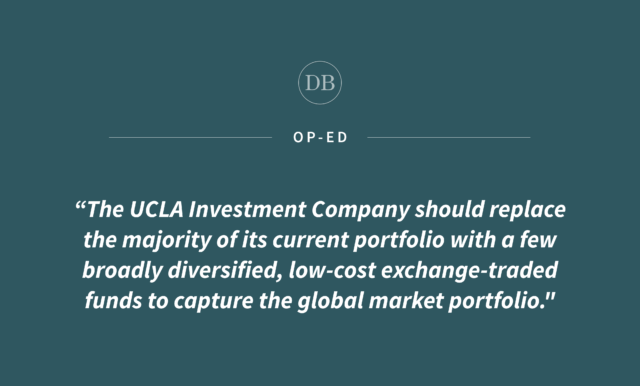The Bruins’ March Madness run recently ended in a tough loss to North Carolina in the Sweet 16. The men’s basketball team has produced 11 NCAA championships – 10 of those under coach John Wooden – and made 51 tournament appearances, completely trouncing the Ivy League.
UCLA may be synonymous with basketball, but when it comes to investing, Ivy League schools are considered to be at the top of their game.
University endowments, specifically for the Ivy League, have been under the microscope over the past decade. It’s become increasingly clear that the use of complex fund structures paired with high management fees can lead to underwhelming investment results.
UCLA’s nearly $5 billion endowment has also struggled for some time now. The UCLA Investment Company, which provides professional stewardship of investment assets entrusted to The UCLA Foundation, has underperformed its stated benchmark for the past one, three, five and 10 years for the fiscal year ending June 2021. UCLA also performed the worst out of all University of California schools in the past three and five years during the same time frame.
Most university endowments subscribe to an investment philosophy known as the Yale Model, which was created by David Swensen. His playbook was marked by active management and close relationships with fund managers, along with high allocations to private equity, venture capital and real assets.
In the year 2000, Swensen published a groundbreaking book called “Pioneering Portfolio Management: An Unconventional Approach to Institutional Investment” after 15 years at the helm of Yale. His framework has long been considered the gold standard in how university endowments deploy capital. But that’s starting to change now with over a decadelong period of underperformance from many schools.
The endowment model hasn’t been without controversy. Some argue Yale’s Investment Office has been an outlier, as peers have struggled to replicate the same success. According to research from Markov Processes International, Ivy League endowments embarrassingly struggled to outperform a basic portfolio of 60% stocks and 40% bonds for a 10-year period ending in 2020.
This past year was the 12th one in a row that Harvard Management Company underperformed in the stock market as a whole. As noted by the Harvard Crimson, the university would have been better off with simple passive index funds that track a basket of predetermined stocks rather than using active managers. With this strategy, they could have saved close to half a billion dollars in salaries and generated billions more in returns.
Surprisingly, the overwhelming majority of research shows large institutions aren’t the sophisticated investors mainstream media makes them out to be. In fact, they’re subject to the same behavioral biases as retail investors.
What many people don’t know is Swensen also authored another, mostly overlooked book in 2005 called “Unconventional Success: A Fundamental Approach to Personal Investment.” In it, he argued for individuals to use lower-cost fund options. By allocating to broad-based exchange-traded funds, investors can get access to entire asset classes such as the United States, international and emerging markets stocks in a single fund for a low cost.
You might ask: If managing an endowment similar to a retail portfolio works so well, why hasn’t it been tried yet? It has – Carthage College in Kenosha, Wisconsin, attracted attention in 2018 for its strong performance using Vanguard index funds. Houghton College in New York also had similar success.
Investing isn’t black and white. There’s room for a mix of different strategies. But the data is in – moving in the direction of lower-cost funds for the majority of the portfolio makes sense, and we don’t need to look far for ideas. These strategies have roots right here at UCLA.
Laurence Fink, the chairman and CEO of BlackRock, is a UCLA alumnus. BlackRock’s iShares are known for democratizing access to global markets with low fees. Bill Sharpe, another UCLA alumnus, shared the Nobel Memorial Prize in Economic Sciences for his groundbreaking work helping to make the argument for indexing. Rob Arnott, founder and chairman of Research Affiliates, once called the “godfather of smart beta” by the Wall Street Journal, served as a visiting professor of finance at the UCLA Anderson School of Management.
Based on a report from Mercer, an outside investment consultant hired to assist with the UC’s investments, an easily replicable and investable global index that reflects traditional risk metrics for the UCLA Endowment is a benchmark consisting of 70% MSCI All Country World Index and 30% Barclays Global Bond Aggregate Index. This type of portfolio has near-full transparency on fees and underlying holdings and would be easy to implement.
The UCLA Investment Company should replace the majority of its current portfolio with a few broadly diversified, low-cost exchange-traded funds to capture the global market portfolio. In doing so, UCLA could be a pioneer, blazing the trail for other universities to also adopt a more transparent, lower-cost investment program – and beat the Ivy League in more than just basketball.
Ryan Ortega holds a certificate in Personal Financial Planning from UCLA Extension.


Comments are closed.